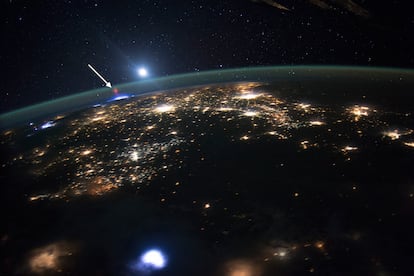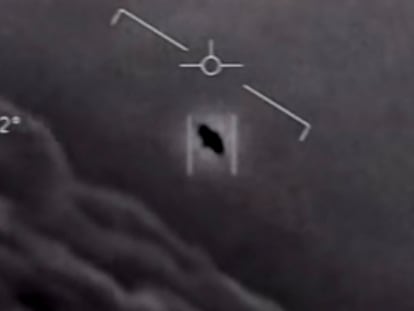NASA appoints UFO research director in the face of ‘one of our planet’s greatest mysteries’
The space agency released the findings after a yearlong study into UAPs (unidentified anomalous phenomena) in which experts warned that there is still not enough data to reach a scientific conclusion on the issue


The conclusion is that there are no conclusions. The team of independent experts appointed by NASA to analyze UFOs or, in a broader sense, unidentified anomalous phenomena (UAP), has presented this Thursday at the headquarters of the space agency in Washington the findings of the yearlong investigation. No extraordinary revelations were made. “Despite numerous accounts and visuals, the absence of consistent, detailed, and curated observations means we do not presently have the body of data needed to make definitive, scientific conclusions about UAP,” says the report, which stresses that the group found no evidence that UAPs are “extraterrestrial” in nature.
UAPs “are one of our planet’s greatest mysteries. Observations of objects in our skies that cannot be identified as balloons, aircraft, or natural known phenomena have been spotted worldwide, yet there are limited high-quality observations. The nature of science is to explore the unknown, and data is the language scientists use to discover our universe’s secrets,” the report reads.
“There’s a global fascination with UAP,” NASA Administrator Bill Nelson acknowledged at Thursday’s presentation of the report. “On my travels, one of the first questions I often get is about these sightings. And much of that fascination is due to the unknown nature of it,” he added. According to the head of the nation’s space agency, much of that fascination is due to their unknown nature. Most UAP sightings result in very limited data, which makes it even more difficult to draw scientific conclusions about their nature, he said. While NASA’s independent investigation found no evidence that UAPs are extraterrestrial in origin, they also did not find a concrete explanation as to what they are. “If you ask me do I believe there’s life in a universe that’s so vast that it’s hard for me to comprehend how big it is, my personal answer is, ‘Yes,’” Nelson admitted.
“Extraterrestrial” appears a dozen times in the report, but almost always to downplay the strength of that hypothesis. “In the search for life beyond Earth, extraterrestrial life itself must be the hypothesis of last resort — the answer we turn to only after ruling out all other possibilities,” reads one of the instances. “To date, in the peer-reviewed scientific literature, there is no conclusive evidence suggesting an extraterrestrial origin for UAP,” the report adds. “When it comes to UAP, the challenge we have is that the data needed to explain these anomalous sightings often do not exist; this includes eyewitness reports, which on their own can be interesting and compelling, but aren’t reproducible and usually lack the information needed to make any definitive conclusions about a phenomenon’s provenance,” the document elaborates at another point.
A new chief of UFO research
Following one of the report’s recommendations, NASA has decided to appoint a director of UAP research who will develop and oversee the implementation of NASA’s scientific vision in the study of anomalous phenomena. He will work in coordination with other government agencies and will use artificial intelligence and machine learning tools. “Whatever we find, we’re going to tell you,” Nelson added, promising transparency on any discoveries. Aside from their scientific interest, UAPs are of interest to both national security and aviation safety.
“The mission of NASA is to find out the unknown,” Nelson said Thursday. “We look for signs of life, past and present. And it’s in our DNA to explore and ask why things are the way they are,” he continued, explaining that in commissioning the study he wanted, first, to examine how NASA can use its expertise and instruments to study UAPs from a scientific perspective. Second, to “change the conversation about UAP from sensationalism to science” and, third, to transparently share whatever findings.
The creation of the independent team was NASA’s first concrete step to seriously examine the phenomena. The appointment of a new head of research on this issue, whose identity has not been disclosed, is another step in the same direction, drawing on the agency’s resources.
“Although NASA’s fleet of Earth-observing satellites typically lack the spatial resolution to detect relatively small objects such as UAP, their state-of-the-art sensors can be directly utilized to probe the state of the local earth, oceanic, and atmospheric conditions that are spatially and temporally coincident with UAPs initially detected via other methods. Thus, NASA’s assets can play a vital role by directly determining whether specific environmental factors are associated with certain reported UAP behaviors or occurrences,”

This work is not strictly speaking a review of the phenomena detected, but rather a methodological approach to what is necessary to better understand the nature of these phenomena in the future. NASA selected 16 people to participate in the study, which started with an additional burden: it focused only on information that was not classified as secret or confidential.
“By setting up this independent study team, NASA gained important external perspectives from leading experts in our nation for how we can use our resources to advance the study of UAP data and explore the unknown in air and space for the benefit of all,” said Nicola Fox, NASA associate administrator.
The team consisted of nine men and seven women, including “some of the world’s leading scientists, data and artificial intelligence professionals, and aerospace security experts,” the agency said. It was headed by David Spergel, president of the Simons Foundation, where he was the founding director of its Flatiron Institute for Computational Astrophysics. His interests range from the search for nearby planets and stars to the shape of the universe. He has measured the age, shape, and composition of the universe and has played a key role in establishing the standard model of cosmology. A MacArthur Genius Fellow, he has been cited in publications more than 100,000 times.
Spergel highlighted the importance of data in the scientific approach to the phenomena, and on the fact that the available data are not conclusive. The report recommends documenting the phenomena with the appropriate methodology, combating the stigma that is sometimes associated with sightings, and advancing knowledge from a scientific perspective.
Although unrelated to this new study, NASA has an active astrobiology program that focuses on the origins, evolution, and distribution of life beyond Earth. From studying water on Mars to probing promising “ocean worlds” such as Titan and Europa, NASA science missions collaborate with the goal of finding signs of life beyond Earth.
Sign up for our weekly newsletter to get more English-language news coverage from EL PAÍS USA Edition
Tu suscripción se está usando en otro dispositivo
¿Quieres añadir otro usuario a tu suscripción?
Si continúas leyendo en este dispositivo, no se podrá leer en el otro.
FlechaTu suscripción se está usando en otro dispositivo y solo puedes acceder a EL PAÍS desde un dispositivo a la vez.
Si quieres compartir tu cuenta, cambia tu suscripción a la modalidad Premium, así podrás añadir otro usuario. Cada uno accederá con su propia cuenta de email, lo que os permitirá personalizar vuestra experiencia en EL PAÍS.
¿Tienes una suscripción de empresa? Accede aquí para contratar más cuentas.
En el caso de no saber quién está usando tu cuenta, te recomendamos cambiar tu contraseña aquí.
Si decides continuar compartiendo tu cuenta, este mensaje se mostrará en tu dispositivo y en el de la otra persona que está usando tu cuenta de forma indefinida, afectando a tu experiencia de lectura. Puedes consultar aquí los términos y condiciones de la suscripción digital.
More information
Archived In
Últimas noticias
There is as much life left to discover on planet Earth as that which is already known
Dozens presumed dead, around 100 injured in fire at Swiss Alps bar during New Year’s celebration
Is porn for women different from conventional porn? We spoke to those who make it
Cartagena de Indias is sinking: What can the city do to mitigate it?
Most viewed
- Sinaloa Cartel war is taking its toll on Los Chapitos
- Reinhard Genzel, Nobel laureate in physics: ‘One-minute videos will never give you the truth’
- Oona Chaplin: ‘I told James Cameron that I was living in a treehouse and starting a permaculture project with a friend’
- David King, chemist: ‘There are scientists studying how to cool the planet; nobody should stop these experiments from happening’
- Why the price of coffee has skyrocketed: from Brazilian plantations to specialty coffee houses










































